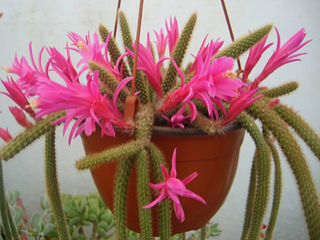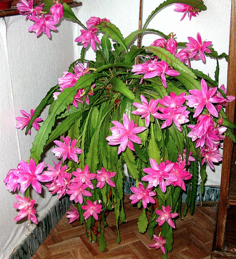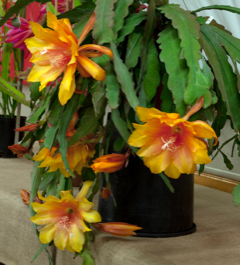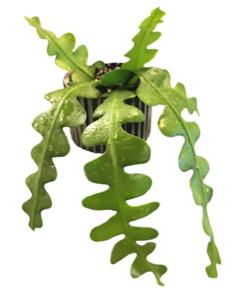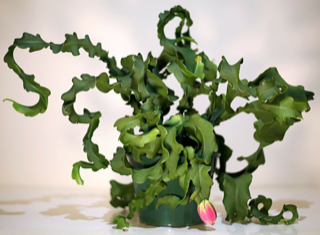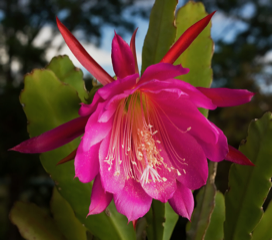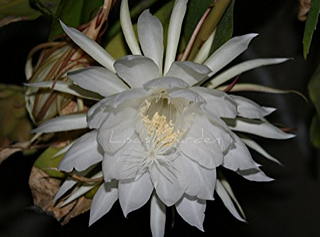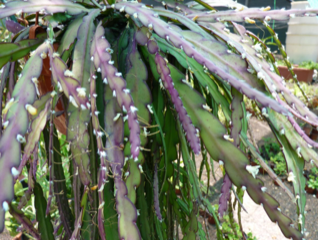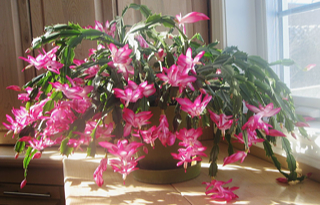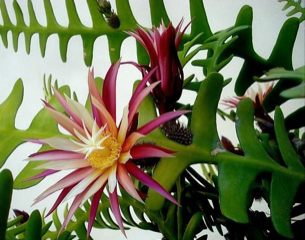Submitted by: Jim Tanner
Epiphytic cacti have a place in every collection. They are easy to grow, requiring remarkably little in the way of care, in general have few spines, and many reward the grower with either a spectacular show of flowers, or a year round display of gracefully curving foliage.
Epiphytic cacti like a richer mix than most ground loving cacti. A frequently used potting mix includes equal parts of potting soil, bark and pumice. Good drainage in the mix is important for good growth. Regular feeding, and a constant supply of moisture, particularly during the growing season are also important. They all like moving air, and do best outdoors, particularly in the summer. Many will get tip damage if left in temperatures below freezing. In a protected area, they can be left outdoors all winter, and do well with our winter rains.
Epiphytic cacti are all easily propagated from either cuttings or seed. Cuttings can be taken any time the plant is in active growth, spring being best, but any time during the summer and early fall will also work. Thin stemmed epiphytes, such as most of the Rhipsalis can be plant immediately. Thicker leafed genera should be allowed to dry for a day or two before planting. Cuttings must be placed in moist potting mix, and kept in the shade for at least a month, but best until active new growth appears. When taking cuttings, remember that the plant will have to live on the stored energy in the stem, and a larger piece, within reason, is better than a small one. Schlumbergia (Zygocactus) can be easily propagated from cuttings, but for successful rooting, two segments need to be used rather than one.
Seed from many of the epiphytic cacti are hard to come by. One or two species are occassionally offered by the CSSA seed bank. For those with an interest in hybridization, many epiphytes are easily pollinated and cross pollinated both within genera, and across genera. Fruit set is frequent. When the fruit turns color and hardens, it can be harvested, the seeds removed, cleaned, and stored until the following spring.
Some choice genera:
Disocactus is a small genus, with flat stems. Native to Guatemala and Honduras. This species can remain small and produces beautiful flowers. It is cold sensitive. The genus has recently been expanded to include other genera.
Epiphyllum is a genus that has been the source of hundreds if not thousands of colorful hybrids. The basic night blooming summer blooming species have been hybridized with Aporocactus and Trichocereus to produce a dazzling array of colorful species. The first big hybridization effort took place in the 1890s, with others following in the 1920s and 1930s. Many spectacular hybrids were created, most lost during World War II. Southern California has been one of the recent hotbeds of hybridization of this species, with spectacular hybrids appearing from the backyards of some gifted plantspeople in San Diego, Palos Verdes and Los Angeles.
Rhipsalis is a species native to Central and South America, Tropical and West Africa, Madagascar and Ceylon. It is the only genus of cacti native to the Old World and Asia. The Old World populations are a separate subspecies of R. baccifera, and differ in the number of chromosomes. This is an incredibly variable genus, with flat leafed forms, twisting thick stems, pencil thin stems, seaweed like forms, all with small white flowers and small white berries. It is easy to grow, and is tolerant of Southern California outdoors conditions all year, with protection required only from the coldest nights and hot sun. Particularly good species include R. mesembryanthemoides, which resembles the growth of the shrubby mesembs of South Africa. R. quellebambensis is a narrow stemmed, frequently branched species, resembling the splashes from a waterfall more than a plant. (It is now a subspecies of R. baccifera.) R. purpusii has long flat leaves, decorated for a good part of the year with either white flowers or white fruit.
Schlumbergia are the Christmas Cacti, popular the world around, easily grown indoors and out. This genus has seen the work of many hybridizers, and spectacular reds, whites, pinks, and mixes of the three can be found every year near the holidays.
Other great genera include Aporocactus, Hatiora, Hylocereus, Wittia, Nopalxochia. There are dozens of obscure genera (many now moved into Disocactus) that are uncommon except among the specialist collector. They all have their charm, and an opportunity to collect any epiphytic cactus with a generic name you are unfamiliar with should never be passed up.
Tom Glavich
LATIN LOOKUP – Loquerisne Latine (Do you speak Latin)?
The meanings of latin plant names on this page – from http://davesgarden.com/guides/botanary/
- anguliger [an-GYOO-lih-ger]
Bearing hooks. - baccifera [bak-IF-er-uh]
Bearing berries. - Disocactus [dy-soh-KAK-tus]
From the Greek dis (twice) isos (equal) and cactus; referring to the equal number of sepals and petals of the flower. - Epiphyllum [ep-ih-FYE-lum]
Upon the leaf, referring to the flowers appearing to bloom on the leaves. - guatemalense [gwa-teh-mah-LEN-see]
Of or from Guatemala, Central America. - Hatiora [hat-ee-OR-uh]
An anagram of Hariota, another genus, named for Thomas Hariot, 16th century British mathematician and cartographer in America. - hybrid [HY-brid]
A cross between two plants resulting in a plant that differs in one or more genes from the parent plants; sometimes Latinized to hybridus, -a, or -um. - oxypetalum [oks-ee-PET-al-um]
Sharp petals. - phyllanthoides [fil-lan-THOY-deez]
Resembles Phyllanthus (from the Greek meaning flower leaf, as it appears to flower from a leaf like stem). - Rhipsalis [RIP-sa-lis]
From the Greek rhips (wicker-work, plaiting) referring to the pliable branches. - salicornioides [sal-eye-korn-ee-OY-deez]
Resembles Salicornia, (from the Greek sal, salt and cornus, horn; referring to the hornlike branches of the saline plants). - Schlumbergera [shlum-BER-ger-uh, shlum-ber-GER-uh]
Named for Frederic Schlumberger, 19th century French gardener and cacti collector. - Selenicereus [sel-ee-nih-KER-ee-us, sel-ee-nih-SER-ee-us]
From the greek selene (moon) and cereus (torch, candle), referring to its nocturnal blooming habit. - truncata [trunk-AH-tuh]
Cut off.
